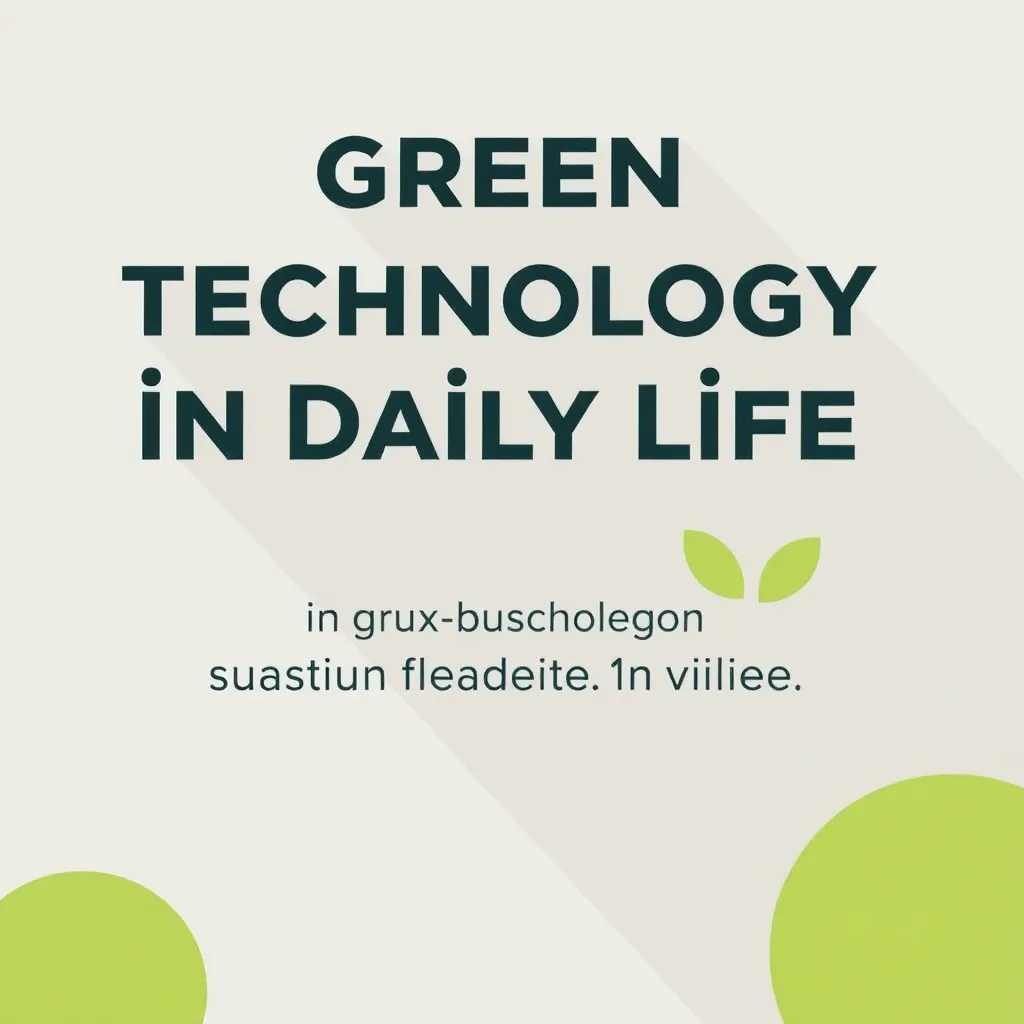
Sustainable Living and Eco-Friendly
Green Technology in Daily Life: A Guide to Sustainable Living


DINKAR
10/24/2024
In today’s world, sustainability is more important than ever. With growing concerns about climate change and environmental degradation, green technology offers a way to reduce our carbon footprint and live more eco-friendly lives. But what exactly is green technology, and how can we incorporate it into our daily routines? This blog will explore various green technologies that you can easily integrate into your daily life to make a lasting impact on the planet.
What is Green Technology?
Green technology refers to the use of environmentally friendly products and services that minimize pollution, conserve natural resources, and promote sustainability. These innovations focus on reducing our reliance on non-renewable energy sources, minimizing waste, and enhancing the overall health of our planet.
Green technology ranges from large-scale systems like solar panels and wind turbines to everyday gadgets that make our homes, workplaces, and lifestyles more energy-efficient. Here’s how you can adopt green technology in your daily life.
1. Energy-Efficient Appliances
One of the easiest ways to incorporate green technology into your daily life is by using energy-efficient appliances. These products, often marked with an Energy Star label, use less electricity compared to traditional appliances. They help conserve energy, reduce greenhouse gas emissions, and save you money on utility bills.
- Energy-efficient refrigerators use up to 40% less energy.
- LED lighting consumes 75% less energy than incandescent bulbs.
- Smart thermostats automatically adjust temperatures to optimize energy use.
Pro Tip: When shopping for new appliances, look for energy efficiency ratings and eco-friendly features that minimize water and electricity consumption.
2. Solar Energy for Homes
Solar panels are perhaps the most recognizable form of green technology. By installing solar panels, you can harness the sun’s energy to power your home, significantly reducing your reliance on fossil fuels.
- Solar panels can generate enough electricity to power all the devices in your home, including lights, heating, cooling, and electronics.
- You can also install solar water heaters to heat your home’s water supply in an eco-friendly way.
The initial investment may be high, but solar panels usually pay for themselves within a few years due to reduced energy costs. Additionally, many governments offer tax credits or rebates for homeowners who install solar panels.
3. Smart Home Technology
Smart home technology is becoming more popular as people look for ways to automate their homes while making them energy-efficient. These systems allow you to control your home’s lighting, heating, and even appliances remotely, ensuring you only use energy when needed.
Some examples of smart home technology include:
- Smart plugs that turn off appliances when not in use.
- Smart thermostats that adjust temperature settings based on your schedule.
- Energy management systems that provide real-time data on energy usage, helping you make more informed decisions.
These technologies contribute to a more efficient home, conserving energy and lowering your monthly utility bills.
4. Electric Vehicles (EVs)
Transportation is one of the largest sources of carbon emissions globally, but electric vehicles (EVs) offer a cleaner alternative to traditional gasoline-powered cars. EVs use electric motors powered by rechargeable batteries, reducing your reliance on fossil fuels.
- Battery electric vehicles (BEVs) run entirely on electricity.
- Plug-in hybrid electric vehicles (PHEVs) use both electricity and gasoline, giving you more flexibility.
EVs are becoming more affordable, and charging infrastructure is expanding, making them a practical option for more people. Many countries also offer tax incentives or subsidies for purchasing electric vehicles, further reducing the cost.
5. Water Conservation Technologies
Water is another crucial resource we need to conserve. Green technology offers several ways to reduce water waste in our daily lives. Some effective solutions include:
- Low-flow showerheads and faucets, which reduce water consumption by regulating water flow.
- Dual-flush toilets, which use different amounts of water depending on whether you’re flushing liquid or solid waste.
- Rainwater harvesting systems, which collect rainwater for use in gardening or household cleaning.
These technologies not only help save water but can also significantly reduce your water bills.
6. Sustainable Building Materials
If you're planning to build or renovate your home, consider using sustainable building materials. Green technology has revolutionized the construction industry, offering materials that are both durable and eco-friendly.
- Recycled steel and bamboo flooring are strong alternatives to traditional materials.
- Insulated concrete forms (ICFs) can help reduce energy consumption by improving your home's thermal efficiency.
- Cool roofing materials reflect more sunlight and absorb less heat, reducing the need for air conditioning.
Using these materials in construction and renovation projects ensures that your home is more energy-efficient and environmentally friendly.
7. Green Gadgets for Daily Life
There are numerous eco-friendly gadgets available that can make your daily life greener:
- Solar-powered chargers for your phone and small devices.
- Eco-friendly reusable batteries, which reduce waste and minimize the demand for disposable batteries.
- Hand-crank radios and flashlights that require no external power sources.
These gadgets are small but make a significant impact by reducing your reliance on disposable products and non-renewable energy sources.
8. Composting and Waste Reduction
Reducing waste is a key aspect of green technology. One of the best ways to manage organic waste is through composting, which turns kitchen scraps and yard waste into nutrient-rich compost for your garden. You can:
- Use compost bins to break down organic materials like vegetable peels, coffee grounds, and paper.
- Opt for compostable or biodegradable bags for waste disposal.
Additionally, many tech innovations help minimize waste, such as smart trash cans that provide data on waste types or automatic sorting machines that separate recyclable materials.
9. Green Transportation Options
In addition to electric vehicles, there are other eco-friendly transportation methods you can adopt to reduce your carbon footprint:
- Biking or using electric scooters for short trips.
- Public transportation systems that have implemented greener technologies like electric buses and trains.
- Carpooling apps that reduce the number of vehicles on the road.
By choosing sustainable transportation, you contribute to lowering air pollution and conserving energy.
Benefits of Green Technology in Daily Life
Incorporating green technology into your daily routine doesn’t just benefit the planet; it also enhances your quality of life. By reducing energy consumption, you lower your utility bills and conserve natural resources. You also contribute to cleaner air, water, and ecosystems, ensuring a healthier environment for future generations.
Moreover, adopting green technologies often leads to tax incentives, rebates, and long-term financial savings. Whether it's through energy-efficient appliances, solar power, or sustainable transportation, these innovations offer a win-win solution for both you and the environment.
Final Thoughts
Green technology is more accessible than ever, making it easier for individuals and households to live sustainably. From energy-efficient appliances and smart home systems to electric vehicles and sustainable building materials, incorporating green technology into your daily life can have a profound impact on the environment.